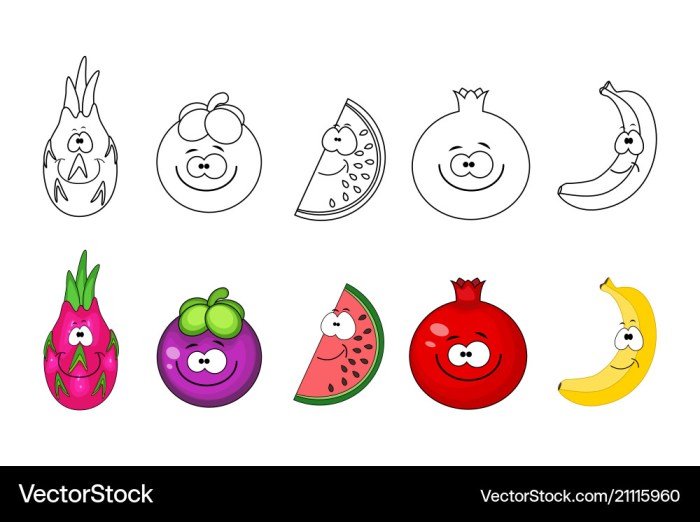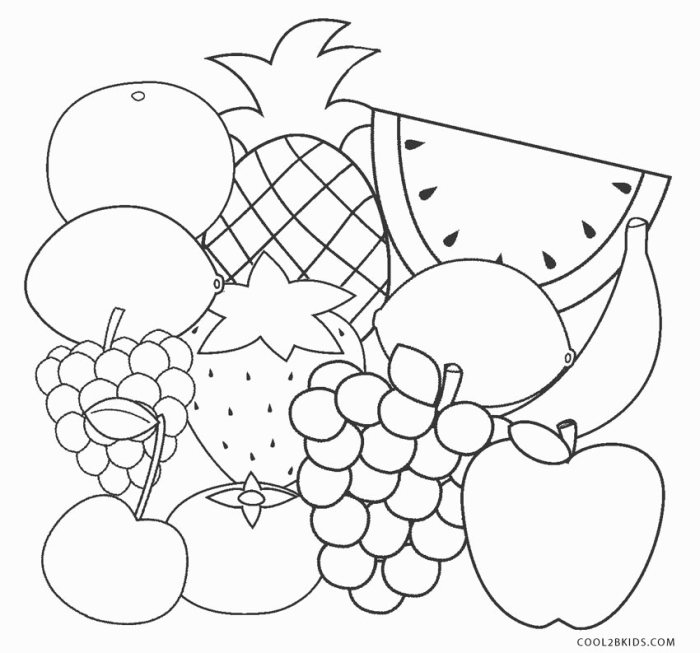Design Elements Exploration

Designing animated fruit coloring pages requires careful consideration of visual style to appeal to a wide age range. The choice of style significantly impacts the overall aesthetic and the ease with which children can color the pages. Three distinct design styles, each with its own unique characteristics, are explored below.
Cartoonish Style
This style prioritizes fun, exaggerated features, and bright colors. Think of the playful aesthetic of classic cartoons. The fruit would be depicted with large, expressive eyes, simplified shapes, and potentially anthropomorphic characteristics – perhaps a smiling strawberry with arms and legs.The color palette would be vibrant and saturated, utilizing bold primary colors and contrasting shades. Think bright reds for strawberries, sunny yellows for lemons, and deep blues for blueberries.
The use of gradients and textures, like a slightly rough texture on the strawberry skin, can add depth without compromising the simplicity of the style.Line art would be thick and bold, easily colored within by young children. Simple, rounded lines are preferred, avoiding intricate details. The lines themselves could be slightly wobbly to maintain the hand-drawn, cartoonish feel.
Realistic Style
In contrast to the cartoonish approach, a realistic style aims for a more accurate representation of the fruit. The fruit would be depicted with detailed textures, subtle shading, and accurate color variations. Think of a high-quality photograph of a fruit bowl, but simplified for easier coloring.The color palette should be nuanced and varied, reflecting the natural color variations within each fruit.
Animated fruit coloring pages offer a vibrant and playful way for children to express their creativity. The bright colors and fun shapes are a great contrast to the more traditional holiday themes, such as the festive designs found in animated christmas bells coloring to print. However, returning to the fruity fun, animated fruit pages provide a delightful alternative, perfect for any time of year and offering a different creative outlet.
For example, a realistic strawberry might showcase a range of reds, from deep crimson to lighter pink, with subtle highlights and shadows. Earth tones could be incorporated to represent stems and leaves.Line art would be thinner and more detailed, emphasizing the natural contours and textures of the fruit. Smooth, flowing lines would be used to depict the curves of the fruit, with subtle variations in line weight to suggest depth and form.
This style would be suitable for older children who enjoy more detailed coloring activities.
Minimalist Style
The minimalist style emphasizes simplicity and clean lines. Fruit would be depicted using basic geometric shapes and limited color palettes. Think of iconic representations of fruits – a simple circle for an apple, a triangle for a slice of watermelon.The color palette would be restricted to a few key colors, often muted or pastel shades. For instance, a minimalist apple might only use shades of red and brown, with no gradients or textures.Line art would be thin and precise, with a focus on clean, sharp lines and angles.
Geometric shapes would be used extensively, with a limited number of lines to define the form of each fruit. This style would be suitable for younger children or those who prefer a simpler coloring experience. The simplicity would allow children to focus on the process of coloring without being overwhelmed by complex details.
Fruit Selection and Animation

Selecting the right fruits for animated coloring pages requires careful consideration of both visual appeal and the ease with which they can be animated. The goal is to create designs that are engaging for children while remaining relatively simple to color and animate. The chosen fruits should lend themselves well to simple animation techniques, avoiding overly complex shapes or details.
The following section details suitable fruits and animation techniques for creating engaging coloring pages.
Fruit Selection for Animated Coloring Pages, Animated fruit coloring pages
Choosing ten fruits that balance visual appeal and animation simplicity is key to a successful project. Consider the shape, color, and potential for adding simple expressions or movements. The following list provides a range of options.
- Apple
- Banana
- Strawberry
- Orange
- Grape
- Watermelon
- Pineapple
- Lemon
- Cherry
- Pear
Animation Techniques for Fruit Coloring Pages
Three animation techniques can enhance the coloring page experience. These techniques should be simple enough to be easily replicated by children while still adding a dynamic element to the static image.
- Simple Movement Suggestions: This involves adding simple lines or arrows to indicate movement. For example, a banana could have a curved line suggesting it’s peeling, or a cherry could have a small trail indicating it’s falling. These suggestions are easily understood by children and require minimal artistic skill to replicate.
- Implied Action Lines: These lines suggest motion without explicitly showing it. A series of slightly overlapping images of a bouncing apple could create the illusion of movement. These lines can also be used to show the fruit rolling or spinning. This technique introduces a more advanced concept of motion but remains visually accessible.
- Expressions: Giving fruits simple facial features (eyes, mouth) can bring them to life. A smiling strawberry or a surprised lemon can add a playful element to the coloring page. This technique requires slightly more artistic skill but offers the highest level of engagement for children.
Fruit Suitability Comparison for Animation
This table compares the suitability of the selected fruits for animation based on several key factors.
| Fruit Name | Animation Potential | Color Complexity | Age Appropriateness |
|---|---|---|---|
| Apple | High (simple shapes, easy to add movement) | Medium (red, green variations) | All ages |
| Banana | High (peeling, bending) | Low (primarily yellow) | All ages |
| Strawberry | Medium (simple movements, expressions) | Medium (red, green, seeds) | All ages |
| Orange | Medium (rolling, slicing) | Low (primarily orange) | All ages |
| Grape | Low (limited movement options) | Low (various shades of purple/green) | All ages |
| Watermelon | Medium (slicing, seeds moving) | Low (primarily green and red) | All ages |
| Pineapple | Low (limited movement options) | Medium (yellow, brown, green) | All ages |
| Lemon | Medium (squeezing, rolling) | Low (primarily yellow) | All ages |
| Cherry | High (falling, bouncing) | Low (primarily red) | All ages |
| Pear | Medium (rolling, falling) | Medium (green, yellow variations) | All ages |
Coloring Page Structure and Layout: Animated Fruit Coloring Pages

Designing effective coloring pages for animated fruits requires careful consideration of layout to maximize engagement and appeal to the target audience. A well-structured page facilitates ease of coloring and enhances the overall visual experience. The layout should be visually appealing and appropriately sized for the intended age group.Different layouts cater to varied preferences and skill levels. Consideration should be given to the complexity of the design and the amount of space available for coloring.
Below are examples illustrating several approaches.
Single Fruit Coloring Page Layouts
Three distinct layouts for a single fruit coloring page are presented below. Each demonstrates a different approach to page utilization and design.
- Full-Page Layout: This layout features a single, large illustration of the fruit dominating the entire page. This provides ample space for detailed coloring and allows for larger, more intricate designs. For example, a full-page illustration of a ripe strawberry, its leaves and stem detailed, would allow for shading and texture exploration within the coloring process.
- Multiple Smaller Images Layout: This layout presents several smaller illustrations of the same fruit in different poses or perspectives on a single page. This encourages creativity and experimentation with color variations. For example, three small illustrations of a banana—one peeled, one unpeeled, and one showing a cross-section—would offer varied coloring opportunities.
- Scene with Multiple Fruits Layout: This approach places a single fruit within a larger scene, incorporating other elements like leaves, flowers, or a background. This adds context and visual interest. For instance, a single apple could be positioned in a basket amongst other fruits, perhaps with a simple background scene like a farmhouse or orchard.
Three Fruit Coloring Page with Animation Technique
This coloring page features an apple, a banana, and a pineapple, employing a stop-motion animation technique. The animation would depict the fruits bouncing playfully. The layout is structured as follows: The page is divided into three distinct sections, each dedicated to a fruit. The apple is positioned in the upper left corner, slightly overlapping the banana in the center.
The banana is depicted mid-bounce, its curved shape emphasized. The pineapple is positioned in the lower right corner, showing a slightly tilted position. Each fruit is clearly separated but the overall composition suggests movement and interaction. Simple background lines suggest a playful, slightly tilted plane, enhancing the illusion of bouncing. The line art style is simple, with bold Artikels and minimal detail to make coloring accessible.
Paper Sizes and Orientations
The choice of paper size and orientation significantly impacts the coloring experience and the final product.
- Letter Size (8.5 x 11 inches) and Portrait Orientation: This standard size is widely accessible and suitable for most coloring projects. Portrait orientation is generally preferred for single fruit layouts or scenes with vertical emphasis.
- A4 Size (210 x 297 mm) and Landscape Orientation: Similar in size to letter, A4 is commonly used internationally. Landscape orientation works well for layouts featuring multiple smaller images or horizontal scenes. This allows for a wider, more expansive presentation.
- Benefits and Drawbacks: Larger formats provide more space for detailed coloring but might be less convenient for younger children. Smaller formats are more portable but might limit the complexity of the design. Orientation choice depends on the layout and the desired visual effect.
FAQ Section
What kind of paper is best for these coloring pages?
Heavier weight paper, such as cardstock, is ideal to prevent bleed-through, especially with markers or watercolors. Thinner paper is suitable for crayons or colored pencils.
Can I sell my designs based on this guide?
This guide provides inspiration and techniques. The legal implications of selling designs based on this content are not covered and should be investigated independently.
How can I add more interactive elements without digital tools?
Consider adding small flaps or die-cut shapes to reveal hidden images or facts. You could also incorporate simple mazes or connect-the-dots activities within the design.
